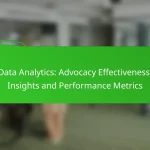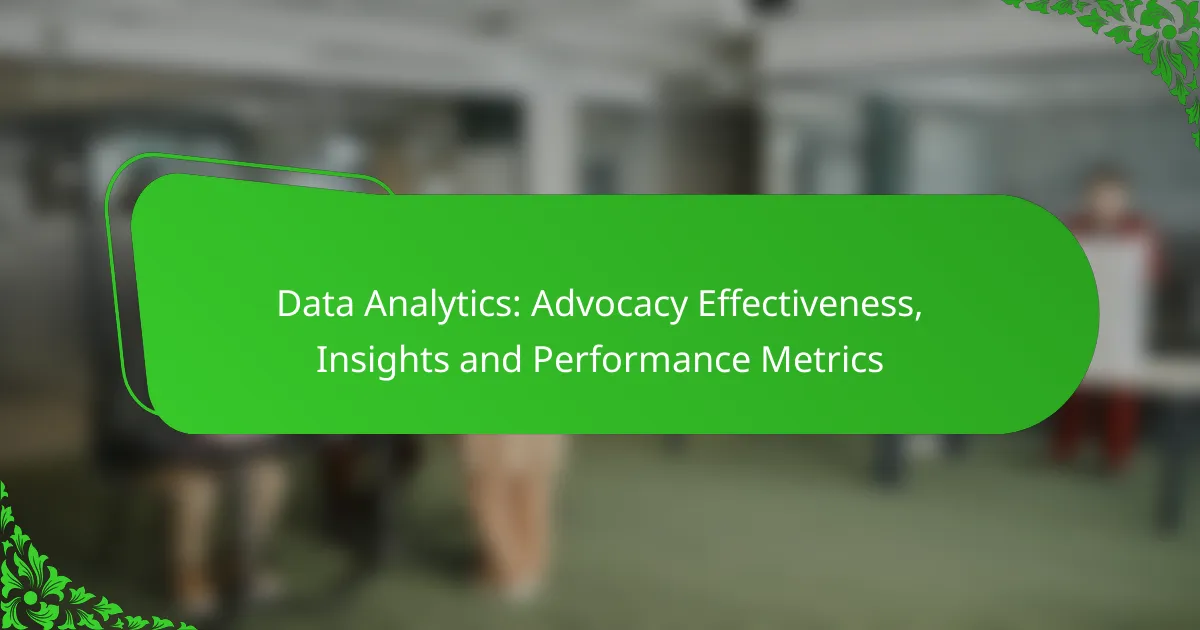Data analytics plays a crucial role in enhancing advocacy effectiveness by offering valuable insights into target audiences and measuring campaign performance. By utilizing key performance metrics, organizations can evaluate their outreach efforts and make informed decisions to optimize engagement with stakeholders. Leveraging the right tools for data visualization and integration further empowers advocates to improve their strategies and achieve better outcomes.
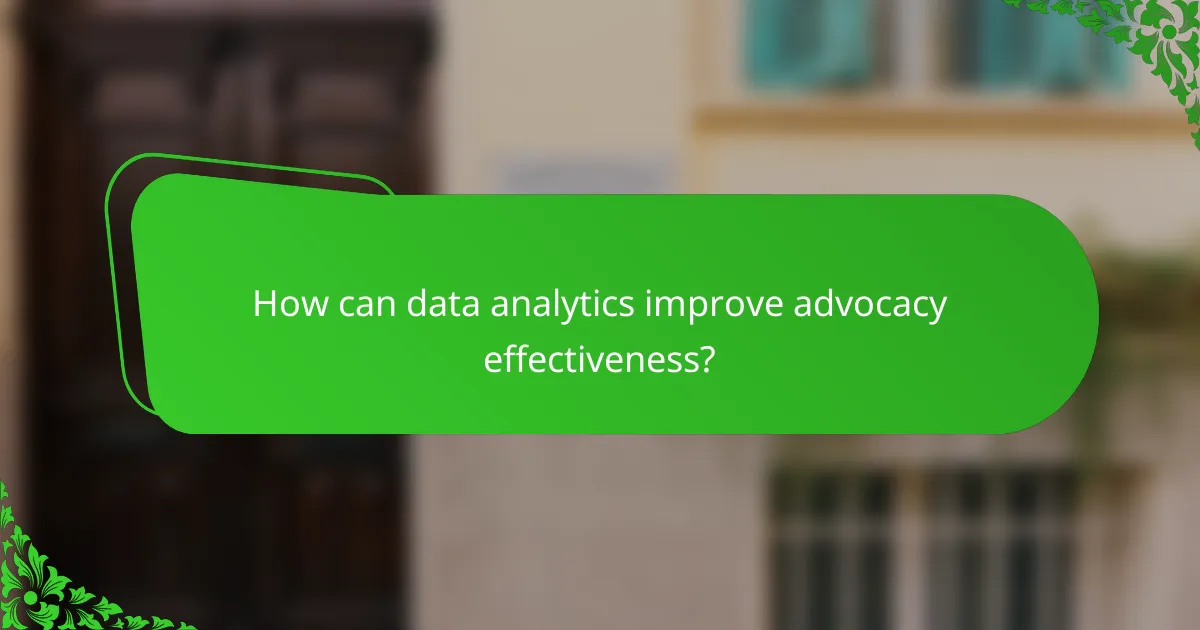
How can data analytics improve advocacy effectiveness?
Data analytics enhances advocacy effectiveness by providing insights into target audiences, measuring campaign performance, and informing strategic decisions. By leveraging data, organizations can optimize their outreach efforts and achieve better engagement with stakeholders.
Enhanced targeting of key demographics
Data analytics allows organizations to identify and segment key demographics based on specific characteristics such as age, location, and interests. This targeted approach ensures that advocacy messages resonate with the right audiences, increasing the likelihood of engagement and support.
For example, an environmental advocacy group might analyze data to focus on younger voters in urban areas who are more likely to support sustainability initiatives. By tailoring messages to these demographics, the group can enhance its outreach effectiveness.
Real-time performance tracking
Real-time performance tracking enables organizations to monitor the effectiveness of their advocacy campaigns as they unfold. By utilizing analytics tools, groups can assess metrics such as engagement rates, social media interactions, and website traffic instantly.
This immediate feedback allows for quick adjustments to strategies, ensuring that resources are directed toward the most effective tactics. For instance, if a particular message is not resonating, it can be modified or replaced without delay.
Data-driven decision making
Data-driven decision making involves using insights derived from analytics to inform strategic choices. Organizations can evaluate past campaign performances to identify successful tactics and areas needing improvement.
By relying on data rather than intuition, advocacy groups can make informed decisions that enhance their overall effectiveness. For instance, analyzing voter turnout data can help determine which outreach methods yield the best results in specific regions.
Improved resource allocation
Data analytics aids in optimizing resource allocation by identifying which initiatives yield the highest return on investment. Organizations can analyze the cost-effectiveness of various advocacy strategies and prioritize funding for those that demonstrate the most impact.
For example, if data shows that digital campaigns generate significantly more engagement than traditional methods, organizations can shift their budgets accordingly. This strategic allocation ensures that resources are used efficiently to maximize advocacy efforts.
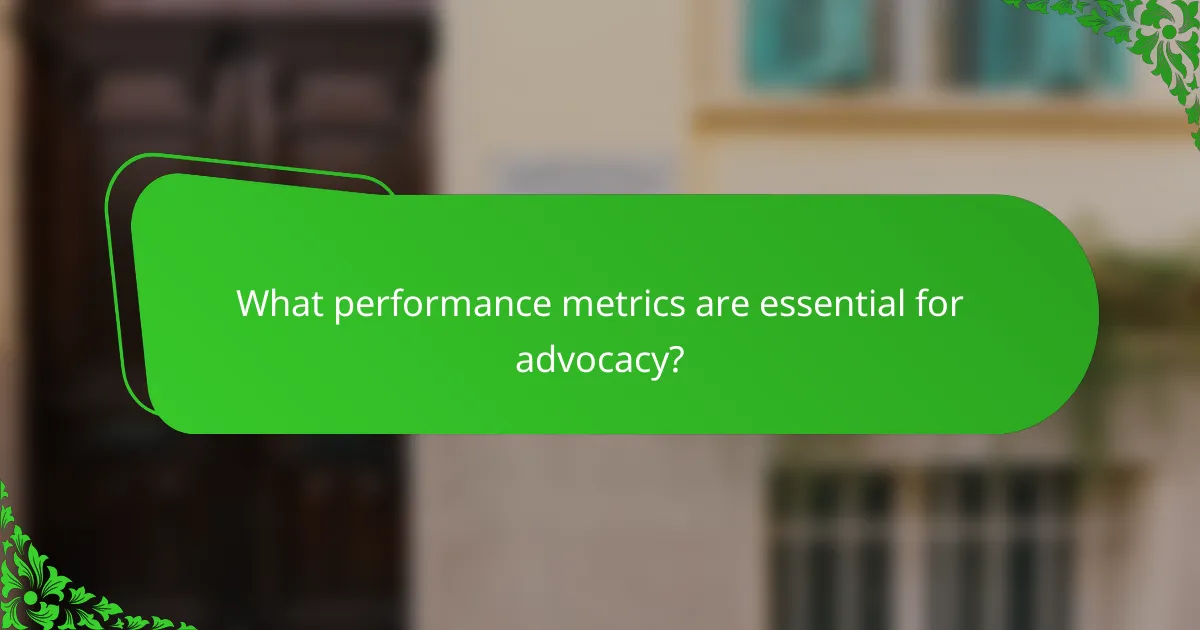
What performance metrics are essential for advocacy?
Essential performance metrics for advocacy include engagement rates, conversion rates, return on investment (ROI), and social media reach. These metrics help organizations evaluate the effectiveness of their advocacy efforts and make informed decisions for future campaigns.
Engagement rates
Engagement rates measure how actively your audience interacts with your advocacy content. This can include likes, shares, comments, and other forms of participation across various platforms. A higher engagement rate typically indicates that your message resonates well with your audience.
To calculate engagement rates, divide the total interactions by the total reach or impressions, then multiply by 100 to get a percentage. Aim for engagement rates in the low to mid-teens for effective advocacy campaigns.
Conversion rates
Conversion rates reflect the percentage of individuals who take a desired action after engaging with your advocacy efforts, such as signing a petition or donating. This metric is crucial for assessing how well your campaign drives specific outcomes.
To improve conversion rates, focus on clear calls to action and ensure that your messaging aligns with the audience’s values. Typical conversion rates for advocacy campaigns can range from a few percent to around 20%, depending on the effectiveness of the outreach.
Return on investment (ROI)
Return on investment (ROI) measures the financial return generated from your advocacy efforts compared to the costs incurred. A positive ROI indicates that your advocacy is financially sustainable and effective in achieving its goals.
To calculate ROI, subtract the total costs of the advocacy campaign from the total revenue generated, then divide by the total costs and multiply by 100. Aiming for an ROI above 100% is generally a good benchmark for successful advocacy initiatives.
Social media reach
Social media reach refers to the total number of unique users who see your advocacy content across social media platforms. This metric is vital for understanding the potential audience size and the visibility of your campaign.
To maximize social media reach, consider using targeted advertising and engaging content that encourages sharing. Effective campaigns often achieve reach numbers in the thousands to millions, depending on the platform and audience engagement strategies employed.
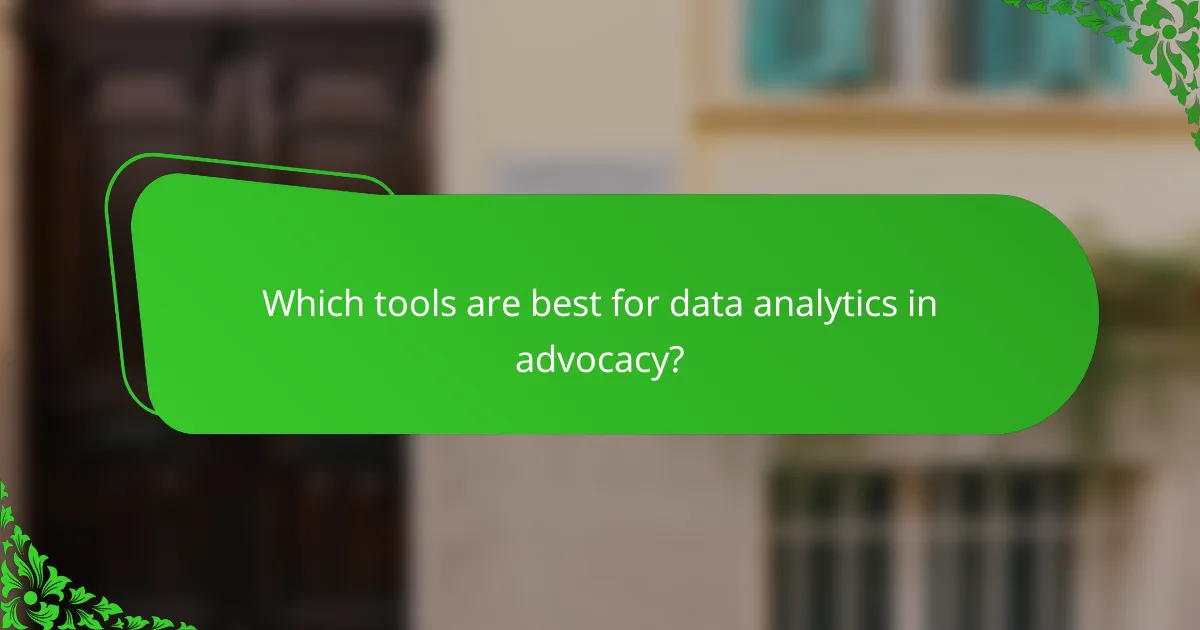
Which tools are best for data analytics in advocacy?
Effective data analytics in advocacy relies on tools that can visualize data, track web performance, and integrate customer relationship management (CRM) systems. The right combination of these tools can enhance decision-making and improve campaign outcomes.
Tableau for data visualization
Tableau is a leading data visualization tool that allows advocates to create interactive and shareable dashboards. It transforms raw data into visually appealing graphs and charts, making complex information easier to understand and communicate.
When using Tableau, consider the types of data you have and how you want to present it. For instance, you can visualize campaign performance metrics or demographic insights to tailor your advocacy strategies. Ensure your data is clean and well-organized to maximize Tableau’s capabilities.
Google Analytics for web performance
Google Analytics is essential for tracking website performance and user behavior, providing insights into how visitors interact with your advocacy site. It helps identify which content resonates most with your audience and where improvements are needed.
To effectively use Google Analytics, set up goals that align with your advocacy objectives, such as newsletter sign-ups or donations. Regularly review metrics like bounce rates and session durations to gauge engagement and make data-driven adjustments to your online presence.
Salesforce for CRM integration
Salesforce is a powerful CRM platform that helps advocacy organizations manage relationships with supporters, donors, and stakeholders. It centralizes data, allowing for better tracking of interactions and campaign effectiveness.
Utilizing Salesforce effectively involves customizing it to fit your advocacy needs, such as tracking volunteer hours or donor contributions. Regularly update your database to ensure accurate insights and consider integrating it with other tools like Tableau for enhanced reporting capabilities.
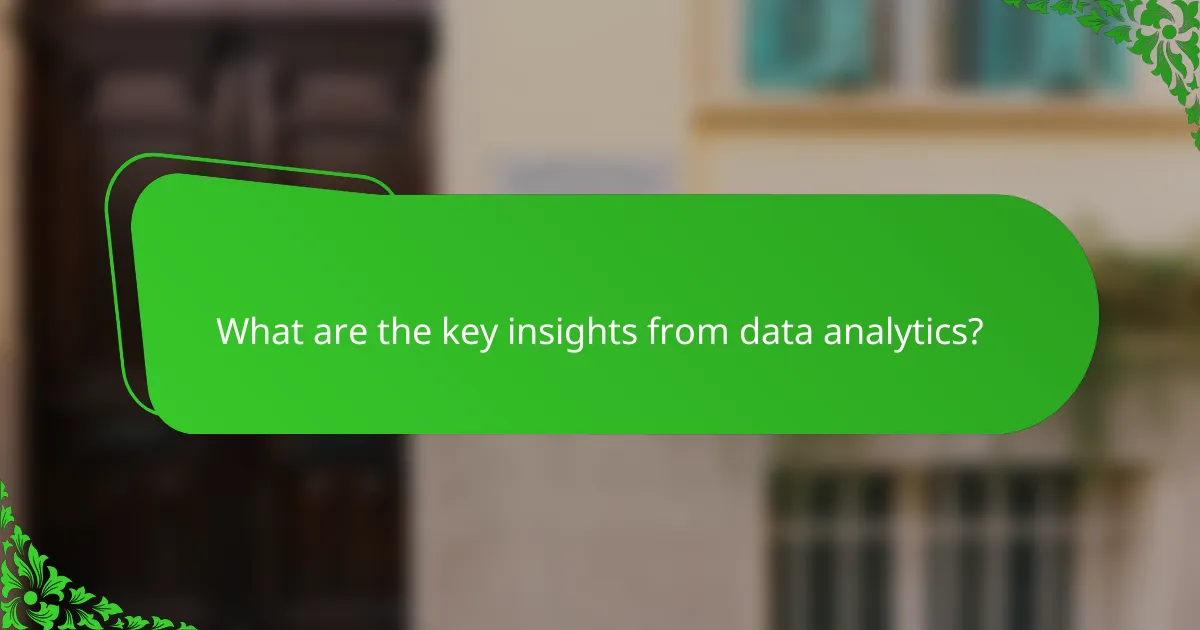
What are the key insights from data analytics?
Data analytics provides critical insights into advocacy effectiveness by revealing patterns, behaviors, and outcomes associated with various strategies. By analyzing data, organizations can identify what works, optimize their approaches, and enhance overall performance metrics.
Trends in voter behavior
Understanding trends in voter behavior is essential for tailoring advocacy efforts. Data analytics can reveal shifts in demographics, preferences, and engagement levels, allowing organizations to adjust their strategies accordingly. For instance, younger voters may prefer digital outreach, while older demographics might respond better to traditional methods.
Key metrics to monitor include voter turnout rates, engagement on social media platforms, and response to different types of messaging. Tracking these trends over time can help predict future behaviors and refine targeting strategies.
Impact of messaging strategies
The effectiveness of messaging strategies can significantly influence advocacy outcomes. Data analytics allows organizations to test various messages and identify which resonate most with their target audience. A/B testing different campaign messages can provide insights into language, tone, and content that drive engagement.
Consider using metrics such as open rates, click-through rates, and conversion rates to evaluate messaging effectiveness. Tailoring messages based on demographic insights can enhance their impact and lead to higher engagement levels.
Effectiveness of outreach campaigns
Evaluating the effectiveness of outreach campaigns is crucial for understanding their return on investment. Data analytics can help assess how well campaigns meet their objectives, whether through increased donations, volunteer sign-ups, or policy changes. Tracking these metrics allows organizations to allocate resources more efficiently.
Common pitfalls include failing to set clear objectives or not measuring outcomes consistently. Establishing key performance indicators (KPIs) at the outset can help guide evaluations and improve future campaigns. Regularly reviewing campaign data will enable continuous improvement and adaptation to changing circumstances.
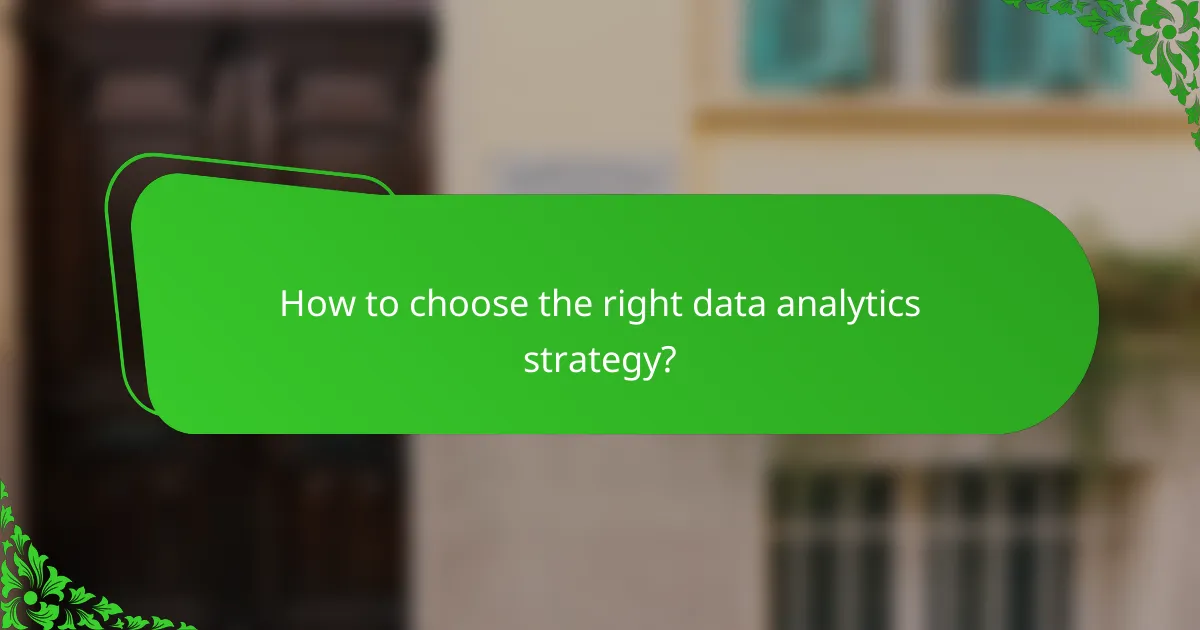
How to choose the right data analytics strategy?
Selecting the right data analytics strategy involves understanding your specific goals, the type of data you have, and the tools available. A well-defined strategy aligns with your organizational objectives and ensures effective use of resources.
Define your objectives
Clearly outlining your objectives is the first step in choosing a data analytics strategy. Determine what you want to achieve, whether it’s improving customer engagement, increasing sales, or optimizing operations. This clarity will guide your selection of tools and methods.
For example, if your goal is to enhance customer retention, focus on analytics that provide insights into customer behavior and preferences. Prioritize strategies that can track and analyze customer interactions over time.
Assess your data sources
Understanding the data sources available to you is crucial for an effective analytics strategy. Evaluate both internal data, such as sales records and customer feedback, and external data, like market trends and competitor analysis. This assessment helps identify which data can provide the most valuable insights.
Consider the quality and volume of your data. High-quality, structured data will yield better analytics outcomes than unstructured or incomplete data. Aim for a mix of quantitative and qualitative data to gain a comprehensive view.
Choose the right tools
Selecting the appropriate tools is essential for implementing your data analytics strategy. Look for software that aligns with your objectives and can handle your data types efficiently. Popular options include Tableau for visualization, Google Analytics for web data, and R or Python for statistical analysis.
When choosing tools, consider factors such as ease of use, integration capabilities, and cost. Many platforms offer tiered pricing, so assess your budget and the features you need to avoid overspending on unnecessary functionalities.
Monitor and adjust your strategy
Regularly monitoring the effectiveness of your data analytics strategy is vital for ongoing success. Set key performance indicators (KPIs) that align with your objectives, and review them periodically to assess progress. This will help you identify areas for improvement.
Be prepared to adjust your strategy based on the insights gained. If certain tools or methods are not delivering the expected results, consider exploring alternatives or refining your approach to better meet your goals.
